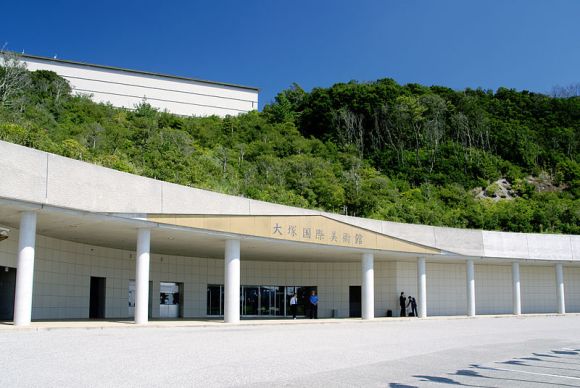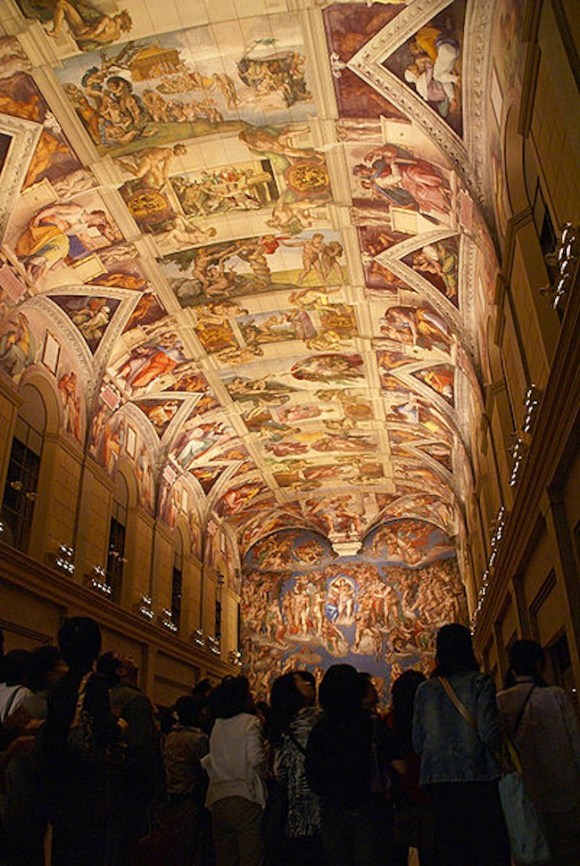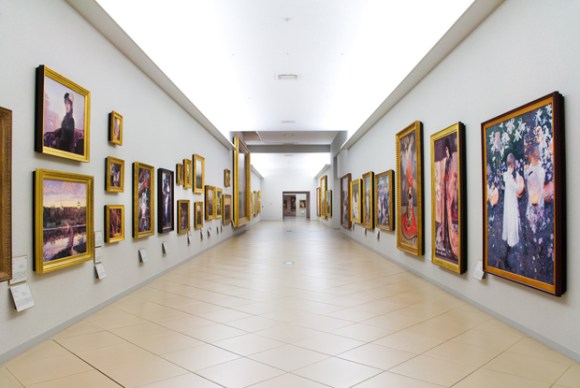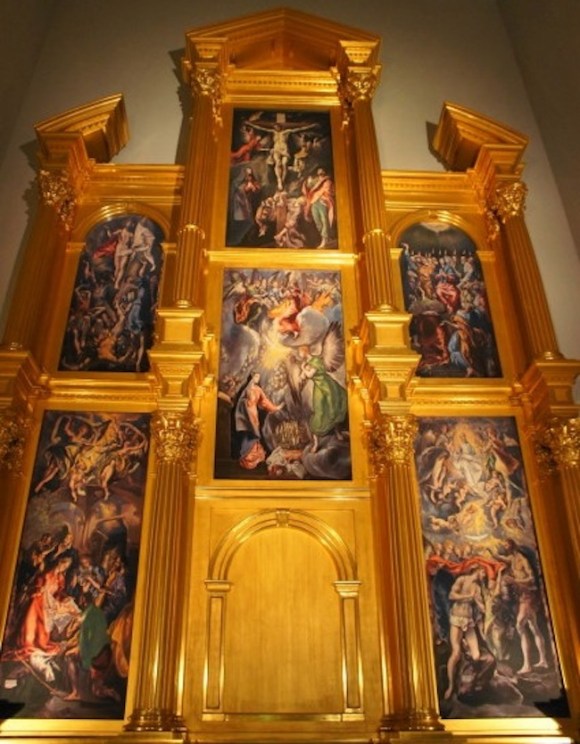
The Otsuka Museum of Art is a place of extremes. It’s the biggest exhibition space in Japan, housing masterpieces of Western art from antiquity to the modern day. The route around its 1,000 artworks is 4km long (2.5 miles), and it takes a full, tiring day to see it all. And with a 3,150 yen (US $29.22) adult admission fee, it’s also Japan’s most expensive gallery.
The works on show are, quite literally, too good to be true. The Mona Lisa, The Last Supper, Guernica, Van Gogh’s Sunflowers, Rembrandt’s self-portraits: everything is here. And every single one of them is a replica. But why are so many people prepared to pay through the nose to see prints of masterpieces?
The museum, which is located near the Naruto Straight in Tokushima-ken, was founded by Otsuka Pharmaceutical in 1998 – the company that brought the world Pocari Sweat and Calorie Mate. It contains more than 1,000 masterpieces of Western art, all of them reproduced onto ceramic boards. As well as replicas of an enormous range of paintings including the complete works of Leonardo da Vinci and all of Rembrandt’s self-portraits, the museum is also home to large-scale reproductions including the interior of the Sistine Chapel and a long-lost El Greco altarpiece.
▼ Possibly contains even more Japanese tourists than the actual Sistine Chapel.
At a whopping 3,150 yen ($29.22) for adult admission, it’s reported to be Japan’s most expensive gallery (for comparison, the National Museum of Modern Art in Tokyo is 420 yen [$3.90]). But the price tag doesn’t seem to have held the Otsuka museum back: in 2011, TripAdvisor users voted it the best museum/art gallery in Japan. (We bet the curators of all those “real” paintings in Japan’s other art galleries were cheering when the Otsuka gallery slid back down to Number 8 in TripAdvisor’s rankings this year.)
Like those copies of entire cities that appear suddenly in China, it’s easy to laugh at this “museum of fakes”. But leaving aside the difference between making replica prints with permission, and breaking architectural copyright, the Otsuka Museum of Art fills the same gap in the market as China’s fake Manhattans and little Venices do: it provides an affordable alternative to travelling abroad to see the originals.
Huge collections of Western art don’t come on tour to Japan: even the relatively large-scale Louvre exhibition coming to Tokyo next year is only 70 pieces. Compared to that, a permanent collection housing 1,000 pieces of Western art – from 25 different countries, no less – starts to sound pretty amazing, even if they are replicas. The original version of Picasso’s ‘Geurnica’ is too delicate to be moved; the El Greco altarpiece ‘Doña María de Aragón’, is split between Madrid and Bucharest.
▼ ‘El Replico’ (they don’t call it that, but they should).
The museum actually attempts to provide a visitor experience that is better than the real thing, freeing visitors from the restrictions that conventional museums have to apply to protect artworks from damage. Photography is allowed in all parts of the Otsuka galleries, and there are no ropes or wires to stand behind. You can stand as close to the replica paintings as you want, and even touch them.
Otsuka’s museum directors see their porcelain replicas as capturing a moment in history: they form a permanent record of the condition these works were in at the turn of the millennium. While the original artworks, scattered around the globe, will continue to fade and deteriorate, the ceramic prints in Tokushima are intended to last for at least another 2,000 years.
Sources: Naver Matome, Otsuka Museum
Images: Wikipedia/663highland, colocal, toffee-chan
Top image: Wikipedia/663highland
Featured image: Tokushima Prefecture Tourism Association




 Japanese beef bowl chain Sukiya’s 2026 Smile Box lucky bag basically pays for itself
Japanese beef bowl chain Sukiya’s 2026 Smile Box lucky bag basically pays for itself Majority of Japanese mayors say foreign residents are essential but most see good and bad effects
Majority of Japanese mayors say foreign residents are essential but most see good and bad effects Pizza Hut Japan’s hot lucky bags are perfect for a New Year’s pizza party
Pizza Hut Japan’s hot lucky bags are perfect for a New Year’s pizza party Should you dip your cake in sake? One Japanese brewer says no, but actually yes【 Taste test】
Should you dip your cake in sake? One Japanese brewer says no, but actually yes【 Taste test】 Japanese city abolishes 88th birthday celebratory money gift because people are living longer
Japanese city abolishes 88th birthday celebratory money gift because people are living longer Japanese beef bowl chain Sukiya’s 2026 Smile Box lucky bag basically pays for itself
Japanese beef bowl chain Sukiya’s 2026 Smile Box lucky bag basically pays for itself Majority of Japanese mayors say foreign residents are essential but most see good and bad effects
Majority of Japanese mayors say foreign residents are essential but most see good and bad effects Pizza Hut Japan’s hot lucky bags are perfect for a New Year’s pizza party
Pizza Hut Japan’s hot lucky bags are perfect for a New Year’s pizza party Should you dip your cake in sake? One Japanese brewer says no, but actually yes【 Taste test】
Should you dip your cake in sake? One Japanese brewer says no, but actually yes【 Taste test】 Japanese city abolishes 88th birthday celebratory money gift because people are living longer
Japanese city abolishes 88th birthday celebratory money gift because people are living longer The heartwarming story of Japan’s “Weakling Gundam” and the fans who supported it in its hour of need
The heartwarming story of Japan’s “Weakling Gundam” and the fans who supported it in its hour of need History’s worst job? Japanese noblewomen used to hire servants to take the blame for their farts
History’s worst job? Japanese noblewomen used to hire servants to take the blame for their farts That time Seiji called JASRAC to ask why he didn’t get paid royalties for his song being on TV
That time Seiji called JASRAC to ask why he didn’t get paid royalties for his song being on TV Japan’s first hotel with a human washing machine is now ready for you to come and bathe in it
Japan’s first hotel with a human washing machine is now ready for you to come and bathe in it Cast of this summer’s live-action Naruto stage play looks more awesome than ever in new photos
Cast of this summer’s live-action Naruto stage play looks more awesome than ever in new photos Starbucks Japan ready to get Year of the Horse started with adorable drinkware and plushies【Pics】
Starbucks Japan ready to get Year of the Horse started with adorable drinkware and plushies【Pics】 Hayao Miyazaki says Happy New Year to Studio Ghibli fans with new art for Year of the Horse
Hayao Miyazaki says Happy New Year to Studio Ghibli fans with new art for Year of the Horse 7 great places to see Mt. Fuji from without having to climb it
7 great places to see Mt. Fuji from without having to climb it We found possibly the quietest Japanese-style hotel in Tokyo’s bustling Shinjuku district
We found possibly the quietest Japanese-style hotel in Tokyo’s bustling Shinjuku district Cup Noodle tries an authentic Jiro-style ramen, but something’s not quite right
Cup Noodle tries an authentic Jiro-style ramen, but something’s not quite right Hello Kitty Choco Egg figures are an adorable trip through three periods of Japanese pop culture【Pics】
Hello Kitty Choco Egg figures are an adorable trip through three periods of Japanese pop culture【Pics】 Japan’s oldest largetooth sawfish in captivity back on display in Mie Prefecture
Japan’s oldest largetooth sawfish in captivity back on display in Mie Prefecture Cyberpunk anime meets traditional culture in Ghost in the Shell gold leaf Japanese changing screens
Cyberpunk anime meets traditional culture in Ghost in the Shell gold leaf Japanese changing screens The best Starbucks Japan Frappuccinos we want to drink again in 2026
The best Starbucks Japan Frappuccinos we want to drink again in 2026 We revisited Sweets Paradise after a decade to see if Japan’s dessert buffet still delivers
We revisited Sweets Paradise after a decade to see if Japan’s dessert buffet still delivers 7-Eleven Japan starts new temporary luggage storage service in over 300 branches
7-Eleven Japan starts new temporary luggage storage service in over 300 branches Disillusionment at Tsukiji’s tourist-target prices led us to a great ramen restaurant in Tokyo
Disillusionment at Tsukiji’s tourist-target prices led us to a great ramen restaurant in Tokyo Starbucks teams up with 166-year-old Kyoto doll maker for Year of the Horse decorations【Photos】
Starbucks teams up with 166-year-old Kyoto doll maker for Year of the Horse decorations【Photos】 Tokyo considering law requiring more trash cans following litter increase in heavily touristed area
Tokyo considering law requiring more trash cans following litter increase in heavily touristed area Tokyo’s Tsukiji sushi neighborhood asks tour groups to stay away for the rest of the month
Tokyo’s Tsukiji sushi neighborhood asks tour groups to stay away for the rest of the month Tokyo event lets you travel back in time, for free, to celebrate 100 years since Showa era start
Tokyo event lets you travel back in time, for free, to celebrate 100 years since Showa era start Sanrio theme park in Japan announces plans to expand into a Sanrio resort
Sanrio theme park in Japan announces plans to expand into a Sanrio resort Japan may add Japanese language proficiency, lifestyle classes to permanent foreign resident requirements
Japan may add Japanese language proficiency, lifestyle classes to permanent foreign resident requirements Stamina-destroying “Paralysis Noodles” are Tokyo’s newest over-the-top ramen innovation
Stamina-destroying “Paralysis Noodles” are Tokyo’s newest over-the-top ramen innovation Survey asks foreign tourists what bothered them in Japan, more than half gave same answer
Survey asks foreign tourists what bothered them in Japan, more than half gave same answer Japan’s human washing machines will go on sale to general public, demos to be held in Tokyo
Japan’s human washing machines will go on sale to general public, demos to be held in Tokyo Japan’s deadliest food claims more victims, but why do people keep eating it for New Year’s?
Japan’s deadliest food claims more victims, but why do people keep eating it for New Year’s? We deeply regret going into this tunnel on our walk in the mountains of Japan
We deeply regret going into this tunnel on our walk in the mountains of Japan Studio Ghibli releases Kodama forest spirits from Princess Mononoke to light up your home
Studio Ghibli releases Kodama forest spirits from Princess Mononoke to light up your home Major Japanese hotel chain says reservations via overseas booking sites may not be valid
Major Japanese hotel chain says reservations via overseas booking sites may not be valid Put sesame oil in your coffee? Japanese maker says it’s the best way to start your day【Taste test】
Put sesame oil in your coffee? Japanese maker says it’s the best way to start your day【Taste test】 No more using real katana for tourism activities, Japan’s National Police Agency says
No more using real katana for tourism activities, Japan’s National Police Agency says Starbucks Japan reveals new sakura drinkware collection, inspired by evening cherry blossoms
Starbucks Japan reveals new sakura drinkware collection, inspired by evening cherry blossoms Updated cherry blossom forecast shows extra-long sakura season for Japan this year
Updated cherry blossom forecast shows extra-long sakura season for Japan this year The heartwarming story of Japan’s “Weakling Gundam” and the fans who supported it in its hour of need
The heartwarming story of Japan’s “Weakling Gundam” and the fans who supported it in its hour of need History’s worst job? Japanese noblewomen used to hire servants to take the blame for their farts
History’s worst job? Japanese noblewomen used to hire servants to take the blame for their farts That time Seiji called JASRAC to ask why he didn’t get paid royalties for his song being on TV
That time Seiji called JASRAC to ask why he didn’t get paid royalties for his song being on TV Japan’s first hotel with a human washing machine is now ready for you to come and bathe in it
Japan’s first hotel with a human washing machine is now ready for you to come and bathe in it Cast of this summer’s live-action Naruto stage play looks more awesome than ever in new photos
Cast of this summer’s live-action Naruto stage play looks more awesome than ever in new photos Japanese burger chain adds crazy new fruit teriyaki burger to its menu for a limited time
Japanese burger chain adds crazy new fruit teriyaki burger to its menu for a limited time Keeping up with the kids: Japanese high schoolers’ most popular slang of Spring 2022
Keeping up with the kids: Japanese high schoolers’ most popular slang of Spring 2022 Tokyo’s newest hot spring bathhouse and foodie spot opening next to Japan’s biggest fish market
Tokyo’s newest hot spring bathhouse and foodie spot opening next to Japan’s biggest fish market Japanese group to hold fashion show of colostomy bags and other stoma equipment in Paris
Japanese group to hold fashion show of colostomy bags and other stoma equipment in Paris We found possibly the quietest Japanese-style hotel in Tokyo’s bustling Shinjuku district
We found possibly the quietest Japanese-style hotel in Tokyo’s bustling Shinjuku district 7-Eleven Japan’s ramen-cooking robot whipped us up a bowl of noodles【Taste test】
7-Eleven Japan’s ramen-cooking robot whipped us up a bowl of noodles【Taste test】 “Dr. Fruit” or “How Japan Learned to Stop Worrying and Love the Peel”
“Dr. Fruit” or “How Japan Learned to Stop Worrying and Love the Peel” You can now buy a Japanese train station clock in Japan
You can now buy a Japanese train station clock in Japan
Leave a Reply